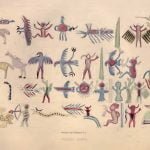The following synopsis, referring by figures to the hieroglyphic devices, exhibits the words of the chants and incantations in their simplest forms, together with the key-sign or ideographic terms of pictorial notation.
Synopsis of Wabeno Songs. Plate 52 (see below)
[one_half]
Chant, or Incantation
1. My lodge crawls by the Wabeno power.
2. Under the ground I have taken him
3. I too am a Wabeno
4. I make the Wabeno dance
5. The sky the sky I sail upon
6. I am a Wabeno spirit this is my work.
7. I work with two bodies.
8. The owl! the owl! the black owl!
9. Let me hunt for it.
10. The burning flames.
11. My little child, I show you pity.
12. I turn round in standing.
13. The Wabeno s power.
14. Wabeno, let us stand.
15. I have made it with my back.
16. I have made him struggle for life.
17. I dance till day light.
18. Dance around.
19. And I too, my son.
20. He that is a Wabeno I fear.
21. Your body I make go.
22. I paint my tree to the sky.
23. I wish a son.
24. My wabeno sky.
25. My body is a great Wabeno.
26. My son s bone the crawling bone.
27. They will fly up, my friends.
28. The turkey I make use of.
29. The wolf s skin I have.
30. There is no spirit no Wabeno spirit.
31. Great Wabeno. I make the Wabeno.
32. What spirit, brother, do you see?
33. At night I come to harm you.
34. At night I come to harm you.
35. I am sitting in the East.
36. With my meda, brother, I shall knock you down.
37. Run, wolf! your body’s mine.
38.
[/one_half]
[one_half_last]
Key-Symbol, or Ideographic term of Notation
A lodge for nocturnal dances.
A man holding a live snake.
The figure of a man sitting, crowned with feathers.
A man standing on half the celestial hemisphere.
A magic bone, decorated with feathers.
A horned serpent.
A hunter with a bow and arrow.
An owl.
A wolf standing on the sky.
Flames.
A human figure with one wing.
A tree.
A female figure.
An artificial figure representing a spirit.
A demoniacal spirit.
A magic bone with wings.
A tree with human legs.
A magic bone.
A drum-stick.
A man with one horn, holding a drum stick.
A headless man standing on the sky, depicted with a charmed heart.
A tree reaching the supposed arc of the sky.
A man, depicted with the emblems of power.
A swallow-tailed hawk.
A man, depicted with one arm, and one horn reversed.
A nondescript bird.
A human body, with the head and wings of a bird.
A turkey.
A wolf.
A flying lizard.
A man with wings and horns.
A pipe.
Symbol of the moon.
Symbol of the sun.
A monster snake, or dragon.
A wolf, depicted with a charmed heart.
A magic bone.
[/one_half_last]

It is manifest from this examination, that there is no clue given to the words of these chants, except that resulting from the power of association of ideas, and that the words must have been committed to memory before this pictorial record could be read, or sung. As an aid to the memory of the Meda, or the Wabeno, seated in a large assemblage, and surrounded with objects suited to withdraw his attention from the chants, and weaken his verbal memory, such inscriptions must be of high use. To others, besides the Medas, Jossakeeds and Wabenos, they must present only such general ideographic information as is denoted by the simple symbols, or representative signs.
